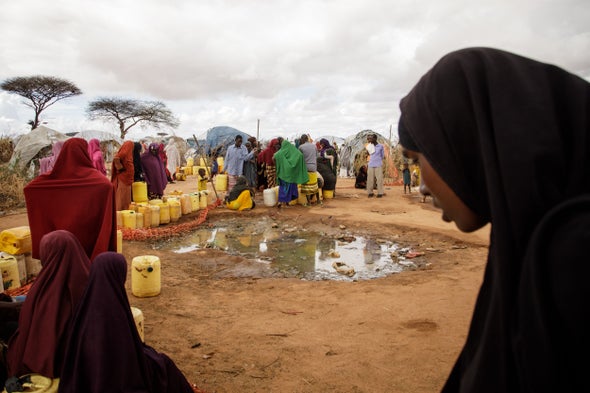Year after year after year the life-sustaining seasonal rains in the Horn of Africa have simply failed to fall. Heat has scorched the soils dry. Crops have shriveled up. Millions of livestock have died. Millions of people face severe food shortages, and several hundred thousand are on the verge of starving to death.
Though the region is no stranger to drought—and the humanitarian crisis in Somalia, Ethiopia and Kenya has received scant international media coverage—the current dry spell is thought to be the worst in several decades. And now a new analysis has found that it would not have happened without human-caused climate change.
The Horn of Africa region has two rainy seasons: the “long rains” that fall from March to May and the “short rains” that do so from October to December. Five of these seasons have failed since 2020, prompting an international group of 19 researchers to try to determine what role climate change may have played in this dearth of precipitation and the resulting devastating agricultural drought. The team’s work is part of the World Weather Attribution (WWA) initiative, an international scientific collaboration that looks for the fingerprints of the climate crisis in extreme events as they happen or immediately afterward.
WWA researchers analyze events by looking for trends in meteorological observations over time and using computer models to compare today’s climate with one without the 1.2-degree-Celsius temperature rise the world has experienced since the late 19th century.
The myriad factors that contribute to drought can make it difficult to analyze—versus, for example, heat waves, which have a more direct and obvious link to global warming. The WWA project looked at changes in precipitation patterns, as well as in evapotranspiration, or how much water is lost from soils and plants.
The team found that the Horn of Africa’s long rains are about twice as likely to experience low rainfall in today’s climate, while the short rains are actually becoming wetter. But that latter trend was overwhelmed in the past few years by an unusually long-lasting La Niña event. This happens when waters across the equatorial Pacific Ocean are unusually cold, leading to changes in the major atmospheric circulation patterns that affect weather around the world.
In this case of this drought, the analysis found that climate change played a major role in increased evaporation because higher temperatures caused soils and plants to dry out much more quickly. If the low rainfall “had happened in a world without climate change, it would not have been classified as a drought because the evaporation would have been so much lower,” said WWA co-leader Friederike Otto, a climate scientist at Imperial College London’s Grantham Institute for–Climate Change and the Environment, on Wednesday at a press briefing to announce the finding.
“These conditions are likely to continue in the future,” said WWA team member Joyce Kimutai of the Kenya Meteorological Department at the briefing. “As the system continues to warm, we’re likely to see the combined effect of low precipitation with temperatures causing really exceptional droughts in this part of the world.”
That drier future is coming despite the fact that the affected countries have done very little to contribute to the climate crisis, which is driven by humans’ relentless burning of fossil fuels.
The results “seem very reasonable,” says Benjamin Cook, a climate scientist at NASA’s Goddard Institute for Space Studies, who researches drought but was not involved in the new analysis. He cautioned that this is “particularly challenging region of the world” to investigate in this kind of study, however, because of a relative sparseness of meteorological data and the complex climatology of the area.
At the press briefing, the team members emphasized that what turns climate hazards into humanitarian disasters is a persistent backdrop of other social, political and infrastructure factors. “What drives food insecurity and famine is, to a very large degree, driven by vulnerability and exposure and not just by the weather events,” Otto said.
The Horn of Africa has been battered by entrenched conflict, the COVID pandemic, deforestation and other unsustainable land-use practices and rising food prices related to the war in Ukraine. All off these factors have increased the vulnerability of the populations in the hardest-hit areas—mostly farmers and pastoralists, who might have the means to deal with one or two missed rainy seasons but have now been pushed beyond their capacity to cope. “This has actually forced people to migrate to other regions in search of water or pasture for their crops or just food for their families,” said Phoebe Wafubwa Shikuku of the International Federation of Red Cross and Red Crescent Societies during the briefing. That migration, in turn, has led to outbreaks of disease such as cholera and an increased risk of gender-based violence.
Mitigating the acute malnutrition and other dangers that have followed this drought will take “working with our communities and preparing them for the worst” in future droughts, Wafubwa Shikuku said. For example, this could mean making sure early warnings of low rainfall reach all involved communities and that farmers and pastoralists have access to drought-resistant crops and livestock breeds. “We might not have that one silver bullet that would create a solution for all,” she said. “It would have to be kind of us creating a buffet of options for our communities that they can be able to select from and combine to be able to address the impacts of the drought—because drought will continue to happen.”


